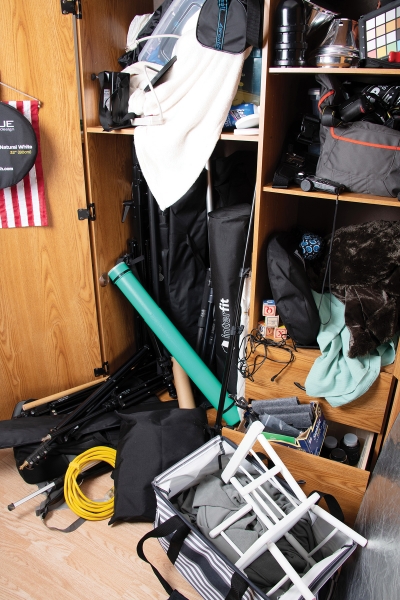Tame Your Studio Equipment Clutter
Weeding out extraneous stuff starts with asking yourself two questions.
• November 2020 issue
As photographers, we don’t just accumulate digital files, we accumulate gear. I’ve run a studio for 15 years, and the numerous equipment upgrades I’ve made in that time have left me with obsolete batteries, chargers, and cords, not to mention a poorly organized equipment cabinet. How do we tame the clutter?

One day, after losing my hot shoe strobe transmitter somewhere in the studio, I decided there had to be a better way. I needed to find an efficient method for finding things quickly. I knew to look in a particular cabinet for a camera or lighting equipment, to search a certain shelf for a prop or posing item, but it might take me a while to unearth what I was looking for.
The COVID-19 shutdown proved to give me the time and energy I needed to tackle this organization project. I pulled everything out of my storage cabinet, and made piles all over my camera room. It was amazing to see all the odds and ends I had, some of which hadn’t been used in years. Based on the sheer amount of stuff strewn over the floor, I knew I’d need labeled containers a document detailing each container’s contents to prevent this predicament from reoccurring.
As I sorted through each pile, I asked myself two questions I learned from Dana K. White, author of the book “Decluttering at the Speed of Life: Winning Your Never-Ending Battle with Stuff.”
1. Is this something I would ever really use?
2. If I needed it, where would I look for it?

White’s philosophy goes one step further: Would I remember I had this if I needed it? The point is, we can’t keep everything, and we shouldn’t even try to.
All the old gear I didn’t need anymore went into a donation pile. Rather than trying to sell things like old backdrops and cameras, I pass them on to a local high school photography teacher. It saves me time (compared to listing and selling each item) and allows me to pass on my love of photography to the next generation of artists.
A system slowly emerged as I worked my way through all the piles. I would store current camera bodies and lenses together, with backup camera bodies and lenses in another spot. Studio strobe light modifiers are stored together. Batteries and chargers share a container so that I’d no longer have to open both a cord container and a battery container to charge my batteries. Speedlight accessories belonged with speedlights, naturally.
On my computer, I created a text document to list the contents of each container in detail. As I added gear to a container, I updated the document accordingly. My document also noted what items were in the drawers of my cabinet as well as the bulk area where I store tripods, monopods, light stands, and the like. When I was done, I printed and attached to each container a label and a list of all the contents.
My new system took time to create, but it’s already proven effective. Being able to find my equipment with minimal effort has been fantastic. It’s easy to update my document as I add new items to any given container. Additionally, if I can’t remember what container (or drawer) something is in, I can consult the full document, which saves valuable time.
This may seem simple, right? In truth, I started out well organized, but over the years I added gear without taking the time to think through, develop, and revise my storage system.
The important thing to remember is this: If your system doesn’t work, just change it. Nothing is carved in stone, and sometimes you have to go through several stages of trial and error to arrive at a final solution that works for you since there’s no one right way for everyone. The important thing is to create a system that you’ll be able to use consistently.
I have more tales of reorganization that I’ll share in the coming months.
Betsy Finn owns Betsy’s Photography portrait studio in Dexter, Michigan.
Tags: gear inspiration

